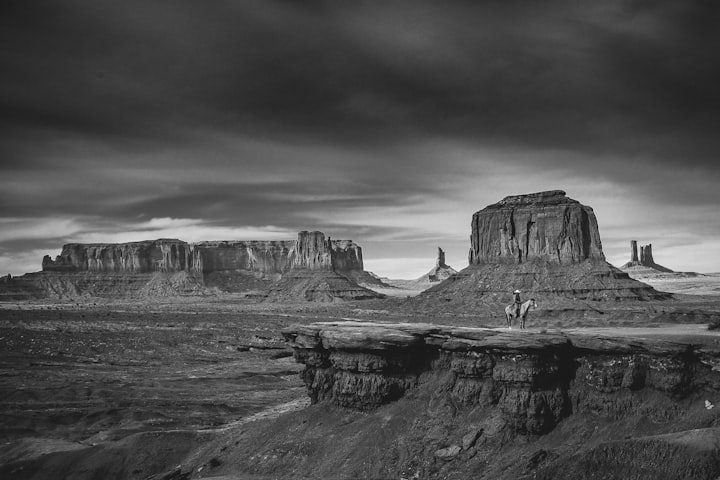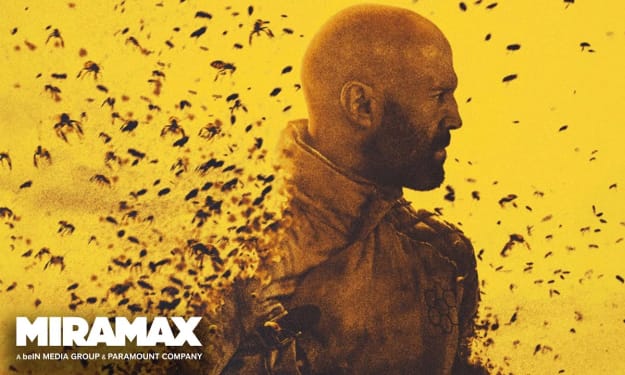
When it is painfully obvious that a certain moment has passed forever, the most sensible thing to do is to reflect, and then move on. Previous attempts to ignite a spark for a once-great art form, have caused me to veer from my perhaps, misguided belief that the Western movie genre could still be revered.
Hopefully, for some, there is still life left for a film form that defined an evolving nation. As a last foray into the realm of one of the 20th century’s most prolific and successful movie genres, three movies epitomizing the Western myth, share unlikely links through political ideology.
With due respect to films such as Leone’s Once Upon A Time In The West, and John Ford’s The Searchers, The Man Who Shot Liberty Valance, and Sam Peckinpah’s The Wild Bunch, the three films I have chosen connect in ways beyond cinematic strengths.
These powerful films define Western mythology, explore the lengths that ‘civilized’ society will go to protect their vision for prosperity, and going one step further, working in a way that bears striking familiarities with the problems of today. Oddly, these films show us a progression that perhaps, in the end, bring us to common ground.
High Noon
This film should come as no surprise to fellow western film lovers. High Noon was a 1952 production directed by Fred Zinneman, filmed at the height of the ‘McCarthy era’ when famous figures in Hollywood were being blacklisted for reportedly communist leanings.
The polarizing effects of the time forced the film industry’s biggest names to choose sides. Democrat, Humphrey Bogart organized the Committee for the First Amendment, while John Wayne’s opposing views caused him to be a leader in the House Un-American Activities Committee. Stanley Kramer’s production of High Noon for several reasons became a lightning rod for the day’s political climate.
Bogart along with partner Lauren Bacall were strenuous objectors to the senate proceedings which attempted to draw out a presumed Communist infiltration in Hollywood and blacklist individuals. High Noon’s premise exposed the dangers of turning one’s fellow citizens.
Never before or since has a film been interpreted so differently by people with opposing views. President Bill Clinton lauded the Will Kane character as a man who stands alone and goes against popular sentiment, likening him to hard-working people in the political arena. President Ronald Reagan offered his praise of High Noon for its stand on law and order.
Conversely, John Wayne called the story of High Noon “the most un-American thing I’ve ever seen in my whole life”, and turned down the role when it was first offered to him. ‘The Duke’ was a self-professed proponent for blacklisting at the time.
How could one ninety-minute, black and white Western create such a stir? There are several reasons, not the least of which is the film’s climax when (spoiler alert) Kane’s Quaker wife shoots a man in the back to save her husband’s life. The testosterone base in Hollywood wanted nothing to do with that sort of ending. Quakers were mortified that Hollywood would force this sort of choice on a deeply religious and pacifist woman.
High Noon gains its cinematic fame for counting down in real-time with the Marshal’s office clock, as Will Kane slowly learns that no one will come to his aid in defending the town. One by one, people the Marshal once knew as friends turn their backs on him with the threat of villainous Frank Miller’s return along with his gang of thugs.
In a desperate attempt to find deputies to back his play, Kane interrupts the local church service to address the townspeople. The church’s pastor is quick to point out that its denomination is different from that of Kane’s new bride. Everywhere Will Kane appears, a new wedge is placed between him and his fellow townspeople.
In an impassioned speech by the town’s mayor, played by inveterate actor Thomas Mitchell, he at first praises the Marshal for his years of good service to the town. Mayor Henderson’s tone then takes a sudden turn when he begins to talk about the prospects for the future in their community.
Concerned with convincing his fellow parishioners that prosperity will only come from a clean image, Mayor Henderson suggests it would be better for the Marshal to leave town before Miller arrives. Wishing to avoid the stigma of a gun battle, the mayor convinces his community to deny Marchal Kane’s request to take a stand.
Bystander apathy, something I have written about before with firsthand knowledge, also rears its ugly head in High Noon. This film is about the willingness of one person to stand alone against all odds, for the sole purpose of doing what he believes is right while others either watch or turn a blind eye.
As far as Kane can see, standing up to thugs is the only decent and right thing to do. Every citizen in town stands by and watches as Kane dispatches the criminals alone, except for the last bullet which comes from the hand of Kane’s wife. If she hadn’t arrived in time, she would have been left a widow.
As his final statement, the Marshal pulls his badge from his vest and crushes it in the dirt before boarding the wagon that will take him and his new bride far from this place. Perhaps this is what John Wayne meant about an un-American sentiment, but it is a theme that is repeated in Westerns to follow.
Lawmen are expected to control dangerous situations without interference or help from ordinary citizens. Wayne made Rio Bravo as an opposing view to High Noon’s message. But in Rio Bravo, Wayne’s Marshal character is backed by deputies.
Hign Noon remains for me, one of the most important cinematic works of the twentieth century. Time ticks on relentlessly through one suspenseful moment after another. Intercutting still shots of relevant characters on both sides with the prisoner’s chair in Kane’s office, the Marshal’s looks of despair, and the fear on the face of his wife, heighten the tension as the clock arm swings closer toward twelve o’clock. From a purely cinematic standpoint, High Noon achieves what film is meant to do. It tells a story visually first.
Gary Cooper, who was well down on a list of actors offered the leading role, won an Oscar for his performance. Ironically, it was John Wayne who accepted the award on Cooper’s behalf as he was filming in Europe. Gary Cooper was also a conservative and a Republican, but when Stanley Kramer’s co-producer, Carl Foreman came under scrutiny at the McCarthy hearings, it was Cooper who came to his defense.
High Plains Drifter
The very mention of Clint Eastwood’s name brings controversy. There is no questioning the polarizing affect his career and his film persona have on the viewing public. Still, it is difficult to argue against his mastery behind a movie camera. Hollywood’s greatest filmmakers list is littered with unlikeable characters. Their artistry, however, is unmistakable.
A film that solidified Clint Eastwood’s Western persona as the nameless stranger, High Plains Drifter deals unabashedly with the brutality of the open frontier. It also serves as one answer to the “What if?” question left in the aftermath of High Noon.
What if the Marshal had lost and the villains had prevailed?
Borrowing an iconic shot from Lawrence of Arabia, the film opens with the expanse of a western plain and a single horse appears in the distance. The heat of the desert floor diffuses the image of the lone rider as he moves closer to the screen.
The stranger rides into the town and he is immediately met with suspicion, loathing, and fear by the citizens of Lago. On his way into town, he rides through a graveyard where the skeletons from a sordid past are buried.
As the narrative unfolds, a dark secret about Lago and its citizens is slowly revealed. The people of Lago stood and watched one night as the mining company’s hired thugs whipped the town Marshal to death. Once again, the lawman was left undefended and unaided as this time, he met a grim end.
Eastwood’s character has come to Lago to play out a vendetta in the name of the deceased Marshal, Jim Duncan. The three men that beat him to death have since been sent to prison, but they are due to be released. Seeing first hand that this man is a cold-blooded killer, the town leaders convince the stranger to stay on as a hired protector against the gang’s imminent arrival.
The stranger insists on impunity, and once granted, he has his way with everyone in town. He takes whatever he wants, including the women. There is no morality in play when one hires a gunman. He will rape their women and give law and order authority to a little man, Mordechai, just to fuel the ire of the town’s leaders. The unnamed assassin orders the citizens to paint the entire town red and paints the word ‘Hell’ over Lago on the town sign.
In the showdown, after training townfolk to defend themselves, the stranger rides off, leaving the townspeople to their own devices. Stunned and fear-struck, they watch their savior disappear into the plain.
The ex-cons arrive to take their revenge on the town that had them put away, and most of the citizens pay the ultimate price. The stranger returns only then to exact his own brand of justice on the three killers.
High Plains Drifter has been interpreted on several levels, mostly because of the ambiguities with the characters. In the final scene, the unnamed rider stops at the graveyard where the little man, the only person Eastwood’s character shows any compassion for, is chiseling out the name, Jim Duncan, on the marshal’s headstone. He says that he never did know the stranger’s name. The horseman looks down on the little man and simply says, “Yes you did”, before riding off.
Eastwood credits his longtime stunt double, Buddy Van Horn, in the part of Marshal Duncan. We are left with the question then, who is Eastwood’s character supposed to be? Is he Duncan’s brother come to avenge his death, or is he Duncan himself, back from the dead?
Perhaps this film is one of the first ‘Living Dead’ movies to be made. The clues are all there. Riding into town through the cemetery, painting the town red, the total disregard for life of any kind remaining in Lago. All of these signs point to a ghostly impression of High Plains Drifter.
Speaking of signs, when Stacey Bridges and his fellow outlaws return to Lago, they never acknowledge the town sign that has been painted over with the word ‘Hell’. Is this film is an allegory, a warning to the wrongs of the future? There are important scenes in this film where Eastwood’s characters question the value of a human life, where people live in consent fear of the image they project to the outside world.
John Wayne also derided this film as a false depiction of the people that tamed the West, but Western mythology serves as an appropriate backdrop for the lessons of High Plains Drifter.
The Duke wasn’t the only Hollywood resider to pan this effort, but he in particular seems bent on protecting a personal image of the West he holds dear. John Wayne’s characters represent the Western as a badge of courage and honor.
Except for his portrayal as Ethan Edwards in The Searchers, a man bent on finding and killing his niece who was taken by Comanche warriors, “The Duke’’s roles are more even-handed. They carry an ethos of respect and fair play. John Wayne’s old West is far more gentile, far more civilized than it actually was.
Which brings us to…
The Shootist
John Wayne’s contribution to American cinema cannot be discounted. More than an icon of the Western genre, the Duke became a driving force in the industry on multiple levels.
Much has been written about Wayne’s health during the making of The Shootest. He was diagnosed with cancer at the time, but his condition had yet to be confirmed as terminal. John Wayne fully expected, perhaps bravely, to continue making more films after The Shootist.
What is more poignant about this film for me, is the interplay between to actors on opposing sides of the political spectrum and how they find common ground. Like her late husband Humphrey Bogart, it was no secret that Lauren Bacall was a staunch liberal. Wayne reportedly asked for Bacall to play the part of Bond Rogers, and despite their political differences, they became good friends while filming.
The story of The Shootist is a twist on the classic Western gunfighter theme. It uses all the classic cues like opponents wishing to gain fame or revenge by bringing down the infamous J.B. Books, John Wayne’s character. For Wayne the film star, this film serves as a vehicle to sum up a storied career as film’s greatest Western icon.
His character has come to the actual town of Carson City, Nevada in 1901, to spend the last days of his life quietly. Set in the era of a dying phase in American history, Wayne’s character is out of place in a time that has passed him by. The last thing Carson City’s law enforcement wants is a gunfight in the center of Western progress. Marshal Thibido calls himself a policeman, signaling the shift in sensibilities in the American West and its view of law and order.
J.B. Books knows he is dying of cancer, so he takes a room in the home of a widow, Bond Rogers, who takes an instant disliking to her lodger. Her main concern is J.B. Books’ attachment to the gun, and the influence it will have on here impressionable teenage son Gillom, played by future filmmaker, Ron Howard.
J.B.’s character softens as the narrative unfolds. He befriends young Gillom and instructs the lad on his personal code of ethics, “I won’t be wronged, I won’t be insulted, and I won’t be laid a hand on.” Carrying through the ‘Golden Rule’ edict, Books concludes with, “I don’t do these things to other people. I require the same from them.” These are sentiments all humanity should be able to agree on, no matter what their political ideals.
Books’ relationship with the boy’s mother is more complex, but gradually, they come to a mutual understanding and respect for each other. For John Wayne, this character study represents his most honest, and I believe his finest performance on screen. Whichever side you may be on with his political stance, John Wayne was an actor who remained true to his persona, on and off the screen.
Other people in town are only concerned with how they can profit from this famous gunman’s death. The undertaker is intent on selling tickets to view Books’ grave. The barber collects hair cuttings of the gunfighter to sell later. Even the stable man Moses has an interest in buying J.B.’s horse and saddle, but at least he’s willing to bargain openly. No one else is unhappy to learn the man is dying, except for Bond Rogers, a woman openly opposed to gun violence, and her son Gillom. The similarity here to HIgh Noon is oddly striking.
In their final scene together before Books sets off to the saloon for the ultimate showdown, the real affection these two actors share for each other is apparent. The scene plays out with genuine affection and mutual respect. Knowing that her boarder is leaving to meet his timely end, Bond watches from her window as Books disappears.
The expression on Lauren Bacall’s face is very readable. It’s not hard to imagine she is thinking of her late husband, Humphrey Bogart during this scene. Their real-life love affair is legendary, and here, her empathy and respect for John Wayne jumps from the screen.
In the end, the storyline in The Shootist falls apart as J.B. Books enters the saloon and faces three unlikely foes. The fault here lies in the poor development of his adversaries’ characters. Alas, there is only so much time for a narrative to play out while maintaining interest.
After dispatching his three foes one by one, Books is ultimately taken down by a shot in the back form a player who has no vested interest in the events unfolding, the bartender.
Gillom arrives just in time to retrieve J.B.’s pistol and gun down the bartender. Books is pleased to see his young charge throw the weapon away just before drawing his last breath.
At the very least, each of these films should leave us thinking about our mutual effect on one another. They are cautionary tales of self versus societal influences.
Many great Westerns were made between these three films and since, but few explore the mythology of Western cinema, better. It’s fitting then, they include three of The Western’s greatest stars.
About the Creator
Stu E
Every Life is a Story-Every Story has a Life. I love to write stories to inspire. Biographies, film reviews, and a touch of humor. Life is for learning, always.






Comments
There are no comments for this story
Be the first to respond and start the conversation.